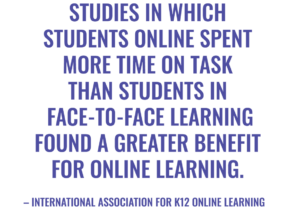Thanks to the novel coronavirus and COVID-19 pandemic that continues to rage across the nation and the world, more students than ever before have experienced a range of differences between attending online vs in-person high school. It’s worth reviewing what those differences are both within the context of a public health emergency as well as when that specific extenuating circumstance doesn’t exist.
Online Learning in a Pandemic is Emergency Learning

When the COVID-19 pandemic first hit, schools quickly shut down to help slow the spread of the novel coronavirus. It was a full-blown public health emergency the likes of which haven’t been seen in over a century. Because of how quickly schools closed, most had only one or two weeks at most to transition from in-person learning to virtual or remote learning.
Needless to say, it wasn’t the smoothest transition in many cases. Not all students have robust internet access. Not all teachers were well-versed in videoconferencing technologies such as Zoom to create virtual classrooms. There was no time to train educators, which means many were at something of a loss for how to translate their lesson plans and learning content into something that could work online.
The point of reviewing what happened in the spring semester of 2020 is to highlight the fact that those who experienced what felt like not very good education and learning need to realize how that wasn’t online learning at its best—it was remote learning in an emergency for which no one was prepared. This is why quite a bit of the reaction to that first round of online learning was captured in headlines like this one from USA Today in June 2020: “‘This is hell’: Parents and kids hate online learning, but they could face more of it.”
Did Virtual Education Improve for the Fall?
Quite a few schools did try to reopen for fully in-person learning in the fall. Other schools opted for a hybrid approach to reduce the number of students coming into a school building, meaning one group of students learn in-person while the others learn remotely, and then they switch off so all students get some of both. In many cases, a lot of schools that tried to fully reopen had to revert back to all-remote or hybrid learning because of the fall wave of COVID-19 cases and infection rates that showed the novel coronavirus was spreading faster than it had in the first wave of spring 2020.
This begs the question: Did online learning get any better for the millions of students who ended up getting more of it than anyone wanted? Generally speaking, it appears not so much. Most schools spent the summer preoccupied with figuring out how they were going to get students back in school safely for in-person learning whether fully in-person or as a hybrid model. There did not appear to be a wide-spread effort to train teachers or better prepare them for remote instruction in the virtual environment.
In part, the lack of more teacher training and preparation for online instruction simply wasn’t possible. Most school districts and teachers’ unions have negotiated how many paid days of training teachers can be required to attend, which still left many teachers with all of a week’s worth of training to be ready for fall remote instruction. In many districts, additional teacher training was made available online, but it had to be considered optional, which means some teachers took advantage of it while many others did not. The New York Times ran a piece called “Lost Summer: How Schools Missed a Chance to Fix Remote Learning.”
For these reasons, many students once again ended up experiencing less-than-stellar online education throughout the fall semester. And there were still all the same disparities in terms of students having or not having the necessary electronic devices and internet access to participate effectively. An article in the Boston Globe article noted how fully 20% of Boston public school students didn’t log in to online learning during the month of May 2020. Way too many learners slipped through the cracks and lost vital academic ground.
What has been Lacking in Online Learning?
There is a laundry list below of why online learning at many public school hasn’t gone well during the pandemic. But this is not hold true same for all online learning. This list is more about what went wrong with last-minute, ill-prepared, emergency e-learning for students who were mostly only used to in-person education:
- Lack of Live Instruction: A surprising number of school districts (as many as two-thirds) didn’t require live remote instruction. This means interactions with teachers were largely by text and email messages. Lessons were often passive, in the form of watching online videos and completing worksheets.
- Lack of Monitoring: In addition, a majority of school districts simply didn’t require the same level of academic monitoring as they normally would. Again, this is understandable in the midst of the initial public health emergency.
- Lack of Intervention: Even when it became clear kids were slipping through the cracks, there simply wasn’t an effective plan of action to intervene and figure out how to get learners back on track.
- Accessibility Disparities: As mentioned, there were a lot of students who either didn’t have the equipment or the internet connection needed to participate, in spite of many schools who tried hard to get tablets in the hands of students, and even set up mobile hotspots in some places to provide connectivity.
- Lack of Teacher Training: Over the summer too many school districts focused on how to safely reopen their school buildings for some amount of in-person learning, which was doomed to not happen when the predicted second wave of infections hit hard in the fall. Fewer than half of all school districts offered any kind of summer teacher training focused on improving the quality of remote instruction.
While the above issues were not rampant in every school district, they were certainly present to some degree in nearly all public schools.
Online Learning Done Right is Very Different from Pandemic Learning
This is all to set up a way of answering the original topic of this article: The differences between attending online vs in-person high school. To assume that online learning during the pandemic is indicative of online learning in general would be a huge mistake. Answering the question has to begin with a recognition that online learning isn’t for everyone, as we’ve described in Is It Right for You? To succeed in online high school the way it would happen when there isn’t a pandemic requires students to be motivated, organized, self-disciplined, and have the support of parents or other family members.
In more optimal (non-pandemic) conditions and for students well-suited to it, online learning has been shown to result in retaining significantly more material than in-classroom learners. These same online learners also tend to learn more quickly when they have the flexibility to move through the material at their own pace, which is why e-learning often takes much less time than classroom instruction. Again, none of this was true for pandemic online learning, but is possible when virtual learning happens in normal conditions with learners who want to learn that way.
Other Differences Between Attending Online VS In-Person High School
Other key differences that stand out when it comes to attending online vs in-person high school is the flexibility teachers have during in-classroom instruction to physically manage how learning happens. Take the formation of small groups. Very easy to do when in-person, and while it’s possible to do it in a live videoconferencing virtual classroom, the quickest way to do it is when the software platform being used (such as Zoom) instantly but randomly assigns breakout rooms, which takes away some of that flexibility the teacher would have in the classroom. Taking the time to form specific breakout groups would take too much time in the online environment.
But this difference only applies to “synchronous” learning sessions where the teacher and students are all online at the same time and able to interact in the virtual classroom. Part of the learner flexibility achieved with most online learning is self-paced movement through asynchronous learning activities.
There is also the matter of receiving one-on-one support from a teacher. This is more a function of class size whether in-person or online. Most online students receive just as much if not more individual support from their teacher than they would in a traditional classroom setting, especially if the physical class has a high number of students.
Achieve Virtual: Online High School for Motivated Learners
At Achieve Virtual Education Academy, we have more than a decade of experience in offering online high school courses to Indiana learners who are motivated to learn, whether it’s to get ahead and finish early or to recover one or more credits to stay on track for graduation. Students who enroll with full-time status pay nothing while part-time students pay a modest fee per course (find more information about this by visiting What Does it Cost?).
Both teenage and adult learners can complete their high school diploma online by taking Achieve Virtual courses all taught by real Indiana teachers who are qualified and certified to teacher in their subjects. The Achieve Virtual online high school program is designed to earn a Core 40 or Core 40 AHD (Academic Honors) as defined by the Indiana Department of Education. while meeting all the state-defined curriculum standards. If you have any questions about Achieve Virtual and how it works, please feel free to call us directly at 317-988-7144 and we’ll be happy to speak with you!


